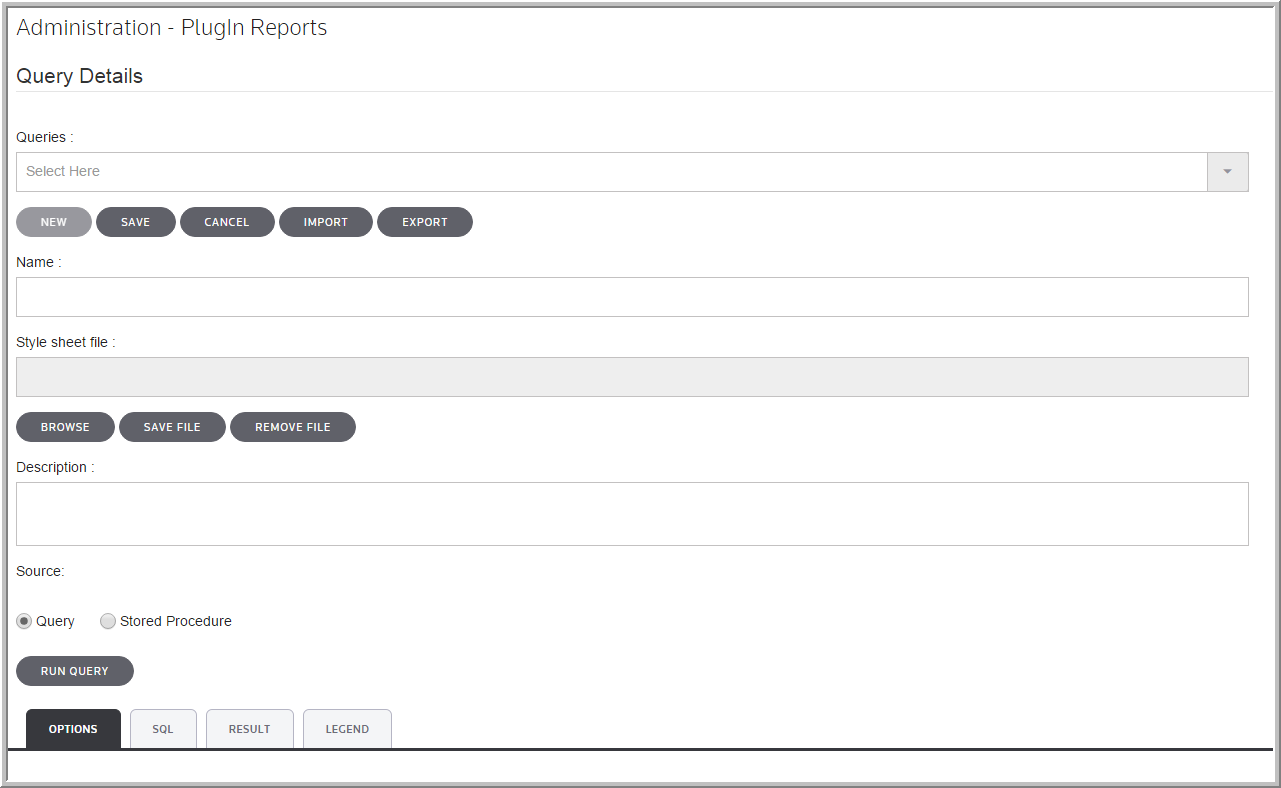Plugin Reports
In Administration > System > Plugin Reports you can create and manage plug-in reports. You must activate the SHOW_PLUGINDEV parameter to use the Plugin Reports. The parameter is activated by importing the Parameter, SHOW_PLUGINDEV with a paramvalue of 1 nto the system.
You can see all selected prompt options when a custom report is selected. You will see a default dataset 1 based on the selection in the Review & Edit.
The functionality expands the types of data that can be brought into a plug-in report. XSL style sheets can be applied to format the queried data and the results can be published in the Reports menu. Using SQL statements, Plugin Reports can query data stored in the application.
1.Select Make available as a custom report and the report will appear in Reporting. If this option is not marked, you can execute the query within the Plugin Reports page.
2.Select the report and then click Run Query.
Query Details
Select Queries to view saved reports. Upon selection of a report, the other fields are automatically populated with the corresponding information for the saved report. You can create New, Import and Export queries.
1.For Queries, click New, Save, Cancel, Import or Export.
•Click New to create a new query.
•Click Save to save the query.
•Click Cancel to cancel the query.
•Click Import to import a query.
•Click Export to export a query.
Note: When you Save a query, the report is saved and published. Once saved, the report can be edited by selecting it from the Queries drop-down list.
2.Type the Name.
3.Select the Style sheet file.
•Click Browse to locate and upload the XSL style sheet for the report.
•Click Save file to save, outside of the application, an already uploaded XSL style sheet being used. This is for editing or backup purposes.
•Click Remove file to change the existing XSL style sheet to a new one. Once removed, a new file can be uploaded by clicking Browse.
4.Type the Description. This field is not required. It is to enter supplemental information about the report you are creating.
5.Select the Source.
a.Query
b.Stored Procedure
6.Select Options.
7.Select the Report Location.
a.Standard
b.Legacy
8.Select the Module.
a.Provision
b.Estimated Payments
c.Interim
9.Select the Menu Location (Report Type). You can select where in the reporting hierarchy the report will appear.
a.Unit
b.Filing Unit
c.Consolidated
d.Sub-consolidated
10.Select Sub Menu Location. You can select where in the reporting hierarchy the report will appear.
a.Federal
b.State
c.State Summary
11.Select Misc.
a.Make available as custom report.
b.Compare Datasets
c.Compare Report Level
d.Prompt for Rollup
•Deferred
•ETR
•Trial Balance
e.Prompt for Class
f.Format results to standard XML.
12.Select SQL.
13.Click Run Query to run the query.
14.Select Result to review the data returned upon running the query.
15.Select Legend.
Notes:
•You can write or copy and paste the SQL Statement for the corresponding report in the Query Details.
•You can specify if a XML Source file is a query or stored procedure.
•The text boxes are displayed to specify the stored procedure and report string variables.
•You can add Dataset Comparison to a plug-in report with a second dataset choice option.
•The functionality is available for Standard and Legacy Reporting.
•To activate Legacy Reporting, in Administration, select Manage Configurations, Reporting, and select Yes to Show Legacy Reports.
Query Details

